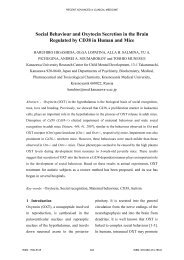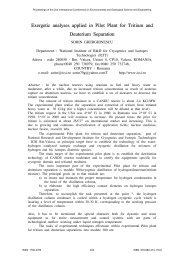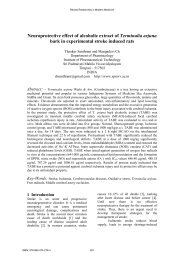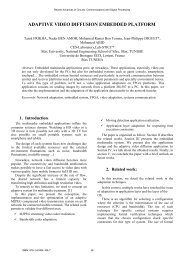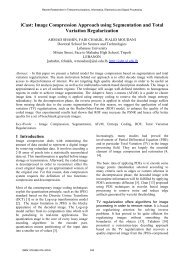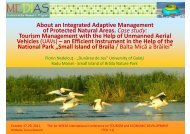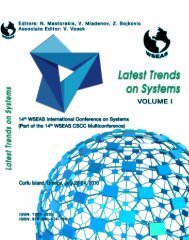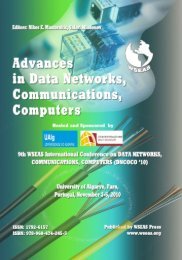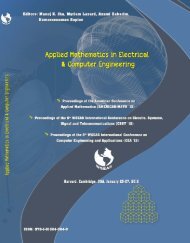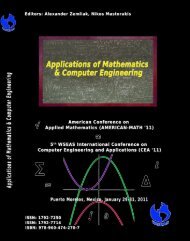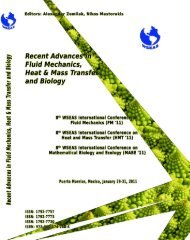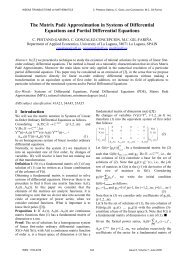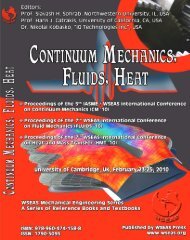Latest trends on urban - Wseas.us
Latest trends on urban - Wseas.us
Latest trends on urban - Wseas.us
- No tags were found...
You also want an ePaper? Increase the reach of your titles
YUMPU automatically turns print PDFs into web optimized ePapers that Google loves.
LATEST TRENDS <strong>on</strong> URBANPLANNING and TRANSPORTATION3rd WSEAS Internati<strong>on</strong>al C<strong>on</strong>ference <strong>on</strong> URBAN PLANNING ANDTRANSPORTATION (UPT '10)Corfu Island, Greece, July 22-24, 2010Mathematics and Computers in Science EngineeringA Series of Reference Books and TextbooksPublished by WSEAS Presswww.wseas.orgCopyright © 2010, by WSEAS PressAll the copyright of the present book bel<strong>on</strong>gs to the World Scientific and Engineering Academy andSociety Press. All rights reserved. No part of this publicati<strong>on</strong> may be reproduced, stored in a retrievalsystem, or transmitted in any form or by any means, electr<strong>on</strong>ic, mechanical, photocopying, recording, orotherwise, without the prior written permissi<strong>on</strong> of the Editor of World Scientific and Engineering Academyand Society Press.All papers of the present volume were peer reviewed by two independent reviewers. Acceptance wasgranted when both reviewers' recommendati<strong>on</strong>s were positive.See also: http://www.worldses.org/review/index.htmlISSN: 1792-4286ISBN: 978-960-474-204-2World Scientific and Engineering Academy and Society
LATEST TRENDS <strong>on</strong> URBANPLANNING and TRANSPORTATION3rd WSEAS Internati<strong>on</strong>al C<strong>on</strong>ference <strong>on</strong> URBAN PLANNING ANDTRANSPORTATION (UPT '10)Corfu Island, GreeceJuly 22-24, 2010
Editors:Prof. Manoj Jha, UNITED STATESInternati<strong>on</strong>al Program Committee Members:Azami Zaharim, MALAYSIABlaise Nsom, FRANCEDimitrios Pavlou, GREECEC Booth, UKR Brandtweiner, AUSTRIAEnrique Arias, SPAINFaridatulazna Ahmad Shahabuddin, MALAYSIAGavriletea Mari<strong>us</strong>, ROMANIAGherghinescu Sorin, ROMANIAG Fadda, CHILES Macedo, BRAZILBruno Grbac, CROATIAClaudio Guarnaccia, ITALYCruceanu Catalin, ROMANIADavid Greiner, SPAINHoratiu Teodorescu, ROMANIAKhan Amanat, BANGLADESHKuei-Yang Wu, TAIWANM.Reza Emami Azadi, IRANMadalina Calbureanu, ROMANIAMatthew Karlaftis, GREECEMichelle Duffy, AUSTRALIAMircea Badescu, ROMANIAMurude Celikag, CYPRUSRoxana Marinescu, ROMANIASaeed-Reza Sabbagh Yazdi, IRANSeyed Yo<strong>us</strong>ef Sadjadi, UNITED KINGDOMShahriar Quayyum, BANGLADESHSlavka Zekovic, SERBIASmaranda Adina Cosma, ROMANIAS<strong>on</strong>ia Degeratu, ROMANIAVassilis Gekas, GREECEAbir Kassem, EGYPTAgita Livina, LATVIAAhadollah A'zami, IRANAndr<strong>on</strong>iki Tsouchlaraki, GREECEAng-cheng kris Ho, TAIWANAsghar Mohammad Moradi, IRANXin Wang, CHINA
PrefaceThis year the 3rd WSEAS Internati<strong>on</strong>al C<strong>on</strong>ference <strong>on</strong> URBAN PLANNING ANDTRANSPORTATION (UPT '10) was held <strong>on</strong> Corfu Island, Greece, July 22-24, 2010. Thec<strong>on</strong>ference remains faithful to its original idea of providing a platform to disc<strong>us</strong>s <strong>urban</strong> planningstrategy and development, social differences and <strong>urban</strong>izati<strong>on</strong>, envir<strong>on</strong>mental protecti<strong>on</strong>,intelligent <strong>urban</strong> planning systems, transportati<strong>on</strong> in the modern city, <strong>urban</strong> tourism, s<strong>us</strong>tainablemarine ecosystems, climate and global change, cleaner energy systems, energy c<strong>on</strong>servati<strong>on</strong> inind<strong>us</strong>try, air polluti<strong>on</strong> and its effects <strong>on</strong> ecosystems, soil and agricultural issues, landscapearchitecture, transportati<strong>on</strong> systems and envir<strong>on</strong>ment, transportati<strong>on</strong> engineering, public healthand transportati<strong>on</strong>, c<strong>on</strong>structi<strong>on</strong>-design of roads, airports and harbours design, fuels and fuelspolicy, air and noise polluti<strong>on</strong>, influence of transportati<strong>on</strong> systems <strong>on</strong> real estate, transportati<strong>on</strong>in extreme weather c<strong>on</strong>diti<strong>on</strong>s etc. with participants from all over the world, both from academiaand from ind<strong>us</strong>try.Its success is reflected in the papers received, with participants coming from several countries,allowing a real multinati<strong>on</strong>al multicultural exchange of experiences and ideas.The accepted papers of this c<strong>on</strong>ference are published in this Book that will be indexed by ISI.Please, check it: www.worldses.org/indexes as well as in the CD-ROM Proceedings. They willbe also available in the E-Library of the WSEAS. The best papers will be also promoted in manyJournals for further evaluati<strong>on</strong>.A C<strong>on</strong>ference such as this can <strong>on</strong>ly succeed as a team effort, so the Editors want to thank theInternati<strong>on</strong>al Scientific Committee and the Reviewers for their excellent work in reviewing thepapers as well as their invaluable input and advice.The Editors
<str<strong>on</strong>g>Latest</str<strong>on</strong>g> Trends <strong>on</strong> Urban Planning and Transportati<strong>on</strong>Table of C<strong>on</strong>tentsPlenary Lecture 1: Strategies of Urban Polluti<strong>on</strong> Diminishing by C<strong>on</strong>trolling Emissi<strong>on</strong>s ofAutomotive EnginesCorneliu Cofaru11Plenary Lecture 2: Traffic Incident Management System in Urban Area 12Sadko MandzukaPlenary Lecture 3: Analysis and CFD Simulati<strong>on</strong> of Flooding Flows and Scouring AroundBridges and Transportati<strong>on</strong> StructuresM. Kostic13Plenary Lecture 4: Blends of Gasoline-Ethanol, Methanol <strong>us</strong>ed in Internal Comb<strong>us</strong>ti<strong>on</strong> Engine 15Charalampos ArapatsakosEc<strong>on</strong>omic Feasibility of a Rainwater Recovery System - Case Study for a Residential Area inPortugalCristina Matos, Julia Lourenco, Luis Ramos, Tiago Pinto, Isabel Bentes17Naturalistic Forest Landscape in Urban Areas: Challenges and Soluti<strong>on</strong>s 21Ilze Jankovska, Inga Straupe, Thomas PanagopoulosTraffic Flow Simulati<strong>on</strong> by 2D Macro- and Microscopic Models 27Boris Chetver<strong>us</strong>hkin, Natalia Ch<strong>urban</strong>ova, Ilya Furmanov, Marina TrapeznikovaAn Urban Chemical Disaster Traffic Simulati<strong>on</strong> Model: A Case Study for No-noticeEmergency Evacuati<strong>on</strong> DevelopmentEvangelos I. Kaisar, Scott A. Parr, Panagiotis Scarlatos33Direct Solar and Diff<strong>us</strong>e Daylight Analysis for Apartment Buildings in Urban Planning 48Hendrik Voll, Teet-Andr<strong>us</strong> Koiv, M<strong>on</strong>ika SergejevaThe Renewal Planning of Migrant Community in Urban Fringe: A Comparis<strong>on</strong> Between theChina and FranceWang Ting53Post-Socialist Transiti<strong>on</strong> and Spatial Development of Serbia 60Miodrag Vujosevic, Slavka Zekovic, Tamara MaricicA Frequent Complain: Cracking of C<strong>on</strong>crete in Slabs-<strong>on</strong>-Ground 66Andreea MirceaRP Surveys <strong>on</strong> Socio-Ec<strong>on</strong>omic, Demographic Characteristics and C<strong>on</strong>sumer Behaviour in aMiddle-Sized City. An Integrated System of Models to Forecast Freight Demand andPassengers Demand for Purchase TripsFederica Crocco, Salvatore De Marco, Pietro Iaquinta, Domenico M<strong>on</strong>gelli70Strategies of Urban Polluti<strong>on</strong> Diminishing by C<strong>on</strong>trolling Emissi<strong>on</strong>s of Automotive Engines 76Corneliu CofaruISSN: 1792-4286 9 ISBN: 978-960-474-204-2
<str<strong>on</strong>g>Latest</str<strong>on</strong>g> Trends <strong>on</strong> Urban Planning and Transportati<strong>on</strong>Data Acquisiti<strong>on</strong> Methods for Estimate the Noise Generated by the Road Traffic 82Daniela Florea, Corneliu Cofaru, Dinu Covaciu, Janos TimarAspects Regarding the Road Traffic Noise and Its Effect <strong>on</strong> the Populati<strong>on</strong> 86Dinu Covaciu, Corneliu Cofaru, Daniela Florea, Janos TimarDefining Semantic Relati<strong>on</strong>s in the Domain of Traffic Engineering: Urban Transport 92Mihaela PopescuThe Methodology of Chemical Pollutants Approximati<strong>on</strong> Model 96Stelian Tarulescu, Corneliu CofaruProject Management for an Earthquake Risk Resp<strong>on</strong>se 102Virgil Popa, Dorina Tanasescu, Mari<strong>us</strong> Gatej, Madalina BarnaPreliminary Study for Implementati<strong>on</strong> of L<strong>on</strong>g Lasting Flexible Road Pavements in Romania 111Andrei Radu, Ioan Tanasele, Elena P<strong>us</strong>lauResearch and Studies of Land Informati<strong>on</strong> System in Some European Countries – EfficientTool to Understand and Manage Urban Development in RomaniaSorin I. Herban117Landscape Evaluati<strong>on</strong> as an Integrant Part of the Rehabilitati<strong>on</strong> Process in Urban Landscapes 123Bibiana Rodrigues Ramos, Thomas PanagopoulosDevelopment of CFD Simulati<strong>on</strong> for 3-D Flooding Flow and Scouring Around a BridgeStructureB. R. Tulimilli, P. Majumdar, M. Kostic, S. A. Lottes129Geoinformati<strong>on</strong> Support – Impact <strong>on</strong> Urban Planning, Envir<strong>on</strong>ment and Society 136Carmen GreceaAnalysis of Agricultural Water-Saving Potential of Handan 142Lixin He, Xiaoqiang Jia, Lina WangFeasibility of Rainwater Utilizati<strong>on</strong> of Handan City 147Lixin He, Xiaoqiang Jia, Lina WangA Novel Parking Soluti<strong>on</strong> for Metropolitan Parking Garages 153Vikas Ganjigunte Ashok, Ajay Gupta, Sandeep Shiva, Hersh Iyer, Darshan Gowda, Srinivas A.The Behaviour of a Metropolis-Hastings Algorithm under Different Prior Distributi<strong>on</strong>s: AnApplicati<strong>on</strong> to Oz<strong>on</strong>e Measurements in Mexico CityJorge A. Achcar, Gisela Ortiz-Rodriguez, Eliane R. Rodrigues160The Relati<strong>on</strong>ship Between Ho<strong>us</strong>ing Market and the Financial Crisis 166Milena Lopreite, Ant<strong>on</strong>io ScarpinoA Cellular Automata Model for Fire Spreading Predicti<strong>on</strong> 173Joseph Quartieri, Nikos E. Mastorakis, Gerardo Iann<strong>on</strong>e, Claudio GuarnacciaPort Management Importance in Port Activities Development 180Mihaela-Carmen Muntean, Daniela Nechita, Costel Nistor, Daniela SarpeAuthors Index 186ISSN: 1792-4286 10 ISBN: 978-960-474-204-2
<str<strong>on</strong>g>Latest</str<strong>on</strong>g> Trends <strong>on</strong> Urban Planning and Transportati<strong>on</strong>Plenary Lecture 1Strategies of Urban Polluti<strong>on</strong> Diminishing by C<strong>on</strong>trolling Emissi<strong>on</strong>s of Automotive EnginesProfessor Corneliu CofaruFaculty of Mechanical EngineeringTransilvania University of BrasovB-dul Eroilor nr.29, BrasovROMANIAE-mail: ccornel@unitbv.roAbstract: This research paper presents an overview of methods of engine emissi<strong>on</strong>s c<strong>on</strong>trolling related toautomotive fleet and road traffic characteristics. As <strong>urban</strong> populati<strong>on</strong>s expand and city roads become increasinglyc<strong>on</strong>gested, city planners need comprehensive <strong>urban</strong> development and transport strategies to address deep-seatedsocial and demographic change.Effective policies m<strong>us</strong>t meet multiple objectives:-Establishing a balance between different modes of transport: public transport, cars, motorcycles, bicycles, andpedestrians;-Providing security, safety and optimum service for transport system <strong>us</strong>ers;-Maintaining the <strong>urban</strong> mobility that drives ec<strong>on</strong>omic development;-Reducing <strong>urban</strong> polluti<strong>on</strong> ca<strong>us</strong>ed by motor vehicles by c<strong>on</strong>trolling emissi<strong>on</strong>s.Nowadays <strong>urban</strong> polluti<strong>on</strong> exposure from road transport has become a great c<strong>on</strong>cern in major cities throughout theworld, for this reas<strong>on</strong>s is presented the most <strong>us</strong>ed active and passive methods for c<strong>on</strong>trolling the motor vehicleemissi<strong>on</strong>s.In this paper, it were presented results obtained <strong>us</strong>ing a model software ADMS - Urban, <strong>on</strong> which ADMS-Roads isbased, for air quality management and assessment studies of complex situati<strong>on</strong>s in towns, motorways, counties andlarge ind<strong>us</strong>trial areas. The ADMS model <strong>us</strong>es advanced algorithms for the height-dependence of all variablesincluding traffic flows, traffic speeds, emissi<strong>on</strong> rates, and the wind speed, turbulence and stability to produceimproved predicti<strong>on</strong>s.Brief Biography of the Speaker:Corneliu Cofaru is a full Professor at the Automotive and Engine Department within the Mechanical EngineeringFaculty from Transilvania University of Brasov, Romania. His area of expertise is the envir<strong>on</strong>mental aspects ofinternal comb<strong>us</strong>ti<strong>on</strong> engines. He authored or co-authored over 200 scientific papers published in reviewed journals orpresented at internati<strong>on</strong>al c<strong>on</strong>ferences organized by FISITA, EAEC, SIAR, etc. He wrote as author and co-author 23books. Two of these are written in English and are entitled: "Materials-Energy S<strong>us</strong>tainable Development" published in2002 and "Transport and Envir<strong>on</strong>mental Engineering" published at the Transilvania University Publishing Ho<strong>us</strong>e in2007. He had the opportunity to manage internati<strong>on</strong>al projects in Temp<strong>us</strong> and Le<strong>on</strong>ardo da Vinci frame and he is amember of Romanian society of automotive engineers.ISSN: 1792-4286 11 ISBN: 978-960-474-204-2
<str<strong>on</strong>g>Latest</str<strong>on</strong>g> Trends <strong>on</strong> Urban Planning and Transportati<strong>on</strong>Plenary Lecture 2Traffic Incident Management System in Urban AreaProfessor Sadko MandzukaFaculty of Traffic Science, Universiry of ZagrebDepartment of Intelligent Transport SystemZagreb, CroatiaE-mail: mandzukas@fpz.hrAbstract: Demand for <strong>urban</strong> traffic and general people mobility is increasing rapidly in Europe crowded cities andtowns. Some new possibilities of <strong>urban</strong> traffic and mobility soluti<strong>on</strong>s, <strong>us</strong>ing new C<strong>on</strong>trol Strategy and IntelligentTransportati<strong>on</strong> System (ITS) approach, are presented. Traffic incident impacts the normal operati<strong>on</strong> of traffic system,even results in paralysis of partial functi<strong>on</strong>s of <strong>on</strong>e city. Researches have shown that automated real-time TrafficIncident Management System (TIMS) can reduce serio<strong>us</strong> c<strong>on</strong>sequences. Some EU experiences about new C<strong>on</strong>trolAlgorithm in Incident Management System in <strong>urban</strong> c<strong>on</strong>diti<strong>on</strong>s are described. It is very important that the final designshould c<strong>on</strong>sider the total life-cycle of the Urban TIMS including not <strong>on</strong>ly the technical merits of potential soluti<strong>on</strong>s butalso the costs and relative value of alternatives. This talk takes forward a research line we started to investigate a twoyear ago and the most promising results are reported.Brief Biography of the Speaker:Prof. Sadko Mandzuka is currently a professor at the Department of Intelligent Transport System, Faculty of TrafficScience, University of Zagreb. He has wide experience in the area of floating vessels c<strong>on</strong>trol theory, IntelligentTransport System, artificial intelligence, traffic incident management system etc. He had the opportunity to work bothin academic and ind<strong>us</strong>trial envir<strong>on</strong>ments including Brodarski Institute, C<strong>on</strong>sulting in the Innovati<strong>on</strong> Area for SME’s,etc. He is currently setting up a spin-off company providing c<strong>on</strong>sulting services for Intelligent Transport System(Incident Management System and other) while at the same time advancing his academic career. He is a foundingmember of Croatian Robotic Associati<strong>on</strong>, vice president of ITS-Croatia, and Collaborating member of CroatianAcademy of Engineering. He is a member of Technical Commitee <strong>on</strong> Marine Systems (Coordinating Committee <strong>on</strong>Transportati<strong>on</strong> and Vehicle Systems - IFAC (Internati<strong>on</strong>al Federati<strong>on</strong> of Automatic C<strong>on</strong>trol ). Finally he has served inthe program committees and as reviewer at several internati<strong>on</strong>al c<strong>on</strong>gress and c<strong>on</strong>ferences. He is author of morethan 70 internati<strong>on</strong>ally reviewed publicati<strong>on</strong>s.ISSN: 1792-4286 12 ISBN: 978-960-474-204-2
<str<strong>on</strong>g>Latest</str<strong>on</strong>g> Trends <strong>on</strong> Urban Planning and Transportati<strong>on</strong>Plenary Lecture 3Analysis and CFD Simulati<strong>on</strong> of Flooding Flows and Scouring Around Bridges andTransportati<strong>on</strong> StructuresProfessor M. KosticDepartment of Mechanical EngineeringNorthern Illinois UniversityDeKalb, IL 60115-2854, USAE-mail: kostic@niu.eduAbstract: Bridges are significant comp<strong>on</strong>ent of the <strong>urban</strong> and ground transportati<strong>on</strong> infrastructure. The ‘bridgehydraulic analysis and design’ could be substantially enhanced <strong>us</strong>ing advanced commercial Computati<strong>on</strong>al FluidDynamics (CFD) software and powerful parallel computing resources. Key objectives are to evaluate the capabilitiesof the state-of-the-art CFD codes for the predicti<strong>on</strong> of experimental results for lift and drag forces and scouring <strong>on</strong>inundated bridges, c<strong>on</strong>ducted at Turner-Fairbank Highway Research Center (TFHRC), and the development of “bestpractices” for the applicati<strong>on</strong> of the CFD. These research activities are part of a multi-year program initiated byArg<strong>on</strong>ne Nati<strong>on</strong>al Laboratory with the US Department of Transportati<strong>on</strong> (USDOT), to establish the Transportati<strong>on</strong>Research and Analysis Computing Center (TRACC), a nati<strong>on</strong>al supercomputing <strong>us</strong>er facility for advanced computing,visualizati<strong>on</strong>, and high-speed networking, based <strong>on</strong> a massively parallel computer system.Early results have foc<strong>us</strong>ed <strong>on</strong> the examinati<strong>on</strong> and determinati<strong>on</strong> of best practices, with emphasis <strong>on</strong> mesh spacing,time step selecti<strong>on</strong> and turbulence modeling. Preliminary two-dimensi<strong>on</strong>al model results show reas<strong>on</strong>able agreementwith limited experimental data. Present work foc<strong>us</strong>es <strong>on</strong> further development and optimizati<strong>on</strong> of the simulati<strong>on</strong>methods and development of three-dimensi<strong>on</strong>al scouring models.Future activities will address diverse research needs of the transportati<strong>on</strong> community in bridge hydraulics, includingthe assessment of lift and drag forces <strong>on</strong> bridge decks when flooded, analysis of sediment transport and its influence<strong>on</strong> scouring, optimizati<strong>on</strong> of bridge deck-shapes to minimize flow forces and pressure flow scour, evaluati<strong>on</strong> of activeand passive scour countermeasures, and addressing envir<strong>on</strong>mental issues such as fish passage through culverts.Brief Biography of the Speaker:Professor Kostic's teaching and research interests are in Thermodynamics (a science of energy, the Mother of AllSciences), Fluid Mechanics, Heat Transfer and related fluid-thermal-energy sciences; with emphases <strong>on</strong> physicalcomprehensi<strong>on</strong> and creative design, experimental methods with computerized data acquisiti<strong>on</strong>, and CFD simulati<strong>on</strong>;including nanotechnology and development of new-hybrid, POLY-nanofluids with enhanced properties, as well asdesign, analysis and optimizati<strong>on</strong> of fluids-thermal-energy comp<strong>on</strong>ents and systems in power-c<strong>on</strong>versi<strong>on</strong>, utilizati<strong>on</strong>s,manufacturing and material processing. Dr. Kostic came to Northern Illinois University from the University of Illinois atChicago, where he supervised and c<strong>on</strong>ducted a two-year research program in heat transfer and viscoelastic fluidflows, after working for some time in ind<strong>us</strong>try.Kostic received his Dipl-Eng (B.S.) degree with the University of Belgrade Award as the best graduated student in1975. Then he worked as a researcher in thermal engineering and comb<strong>us</strong>ti<strong>on</strong> at Belgrade-Vinca Institute for NuclearSciences, which then hosted the headquarters of the Internati<strong>on</strong>al Center for Heat and Mass Transfer, and latertaught at the University of Belgrade in ex-Yugoslavia (*). He came to the University of Illinois at Chicago in 1981 as aFulbright grantee, where he received his Ph.D. in mechanical engineering in 1984. Subsequently, Dr. Kostic workedseveral years in ind<strong>us</strong>try. In additi<strong>on</strong>, he spent three summers as an exchange visitor in England, West Germany, andthe former Soviet Uni<strong>on</strong>.Dr. Kostic has received recognized professi<strong>on</strong>al fellowships and awards, including multiple citati<strong>on</strong>s in Marquis'"Who's Who in the World," "Who's Who in America," "Who's Who in American Educati<strong>on</strong>," and "Who's Who inScience and Engineering"; the Fulbright Grant; NASA Faculty Fellowship; Sabbatical Semester at Fermilab as aGuest Scientist; and the summer Faculty Research Participati<strong>on</strong> Program at Arg<strong>on</strong>ne Nati<strong>on</strong>al Laboratory. He is afrequent reviewer of professi<strong>on</strong>al works and books in Thermodynamics and Experimental Methods. Dr. Kostic is alicensed professi<strong>on</strong>al engineer (PE or P.Eng.) in Illinois and a member of the ASME, ASEE, and AIP's Society ofRheology. He has a number of publicati<strong>on</strong>s in refereed journals, including invited state-of-the-art chapters in theAcademic Press series Advances in Heat Transfer, Volume 19, and "Viscosity" in CRC Press' Measurement,Instrumentati<strong>on</strong> and Sensors Handbook; as well as invited reference articles: Work, Power, and Energy in AcademicISSN: 1792-4286 13 ISBN: 978-960-474-204-2
<str<strong>on</strong>g>Latest</str<strong>on</strong>g> Trends <strong>on</strong> Urban Planning and Transportati<strong>on</strong>Press/Elsevier's Encyclopedia of Energy; Extr<strong>us</strong>i<strong>on</strong> Die Design in Dekker's Encyclopedia of Chemical Processing;and Energy: Global and Historical Background, and Physics of Energy, both in Taylor & Francis/CRC PressEncyclopedia of Energy Engineering and Technology. Professor Kostic is a senior member of the Graduate Faculty atNorthern Illinois University. More at: http://www.kostic.niu.eduISSN: 1792-4286 14 ISBN: 978-960-474-204-2
<str<strong>on</strong>g>Latest</str<strong>on</strong>g> Trends <strong>on</strong> Urban Planning and Transportati<strong>on</strong>Plenary Lecture 4Blends of Gasoline-Ethanol, Methanol <strong>us</strong>ed in Internal Comb<strong>us</strong>ti<strong>on</strong> EngineProfessor Charalampos ArapatsakosDepartment of Producti<strong>on</strong> and Management EngineeringDemocrit<strong>us</strong> University of ThraceV. Sofias Street, 67100, XanthiGREECExarapat@agro.duth.grAbstract: Air polluti<strong>on</strong> is a major global problem as it harms the human respiratory system, plants and property.Am<strong>on</strong>g all the polluti<strong>on</strong> sources in a city the road transport emissi<strong>on</strong>s are often the most important source. Innowadays there is a great increase in car ownership and <strong>us</strong>e. Therefore, it remains to be seen what measures needsto be adopt, in order to reduce emissi<strong>on</strong>s from road traffic and c<strong>on</strong>sequently to prevent transport related air polluti<strong>on</strong>problems. One soluti<strong>on</strong> of reducing emissi<strong>on</strong>s from road traffic is the <strong>us</strong>e of alternative fuels. Alternative fuels arederived from resources other than petroleum. Some are produced domestically, reducing dependence <strong>on</strong> foreign oiland some are derived from renewable sources. Alternative fuels produce less polluti<strong>on</strong> than gasoline or diesel. Thetransportati<strong>on</strong> fuels that are made from biomass through biochemical or thermochemical processes are known asbiofuels. Examples of well known alternative fuels and particularly biofuels include biodiesel, ethanol and methanol.This paper examines the behavior of a small four-stroke engine when mixtures of gasoline-ethanol and gasolinemethanolare <strong>us</strong>ed as fuel. This engine moves a small alternative generator. CO and HC emissi<strong>on</strong>s tests werec<strong>on</strong>ducted <strong>us</strong>ing different mixtures of gasoline-ethanol and gasoline-methanol as fuel, under different load c<strong>on</strong>diti<strong>on</strong>s:under full electrical load and without load c<strong>on</strong>diti<strong>on</strong>s. These tests showed that when the percentage of ethanol andmethanol in the fuel increases the CO and HC emissi<strong>on</strong>s decrease. There was an excepti<strong>on</strong> with the mixtures:gasoline-90%ethanol, 100%ethanol, for which the engine malfuncti<strong>on</strong>ed and the HC emissi<strong>on</strong>s were increased.During the tests the regulati<strong>on</strong> of the engine relatively to the air/fuel ratio, maintained the original adj<strong>us</strong>tment thatc<strong>on</strong>cerned gasoline. It is important to menti<strong>on</strong> that the ethanol that was <strong>us</strong>ed was 95i alcoholic degrees and not 100%pure ethanol. Furthermore, during the <strong>us</strong>e of the mixtures of gasoline-ethanol and gasoline-methanol there was asmall increase of fuel c<strong>on</strong>sumpti<strong>on</strong> when the percentage of the ethanol and methanol in the fuel was increased.Brief Biography of the Speaker:Dr. Charalampos Arapatsakos is a Greek citizen, who has been born in Athens. He has studied Mechanical ofEngineering. He is a Ph.D. Assoc. Professor in the University of Thrace in Greece. At the present he is a member ofTechnical Chamber of Greece, member of Electrical and Mechanical Engineering Associati<strong>on</strong> and member ofComb<strong>us</strong>ti<strong>on</strong> Institute of Greece too. Mr C. Arapatsakos has participated in many research programs about biofuels,gas emissi<strong>on</strong>s and antipolluti<strong>on</strong> technology. His research domains are mainly <strong>on</strong> biofuels and their <strong>us</strong>e in internalcomb<strong>us</strong>ti<strong>on</strong> engines, the power variati<strong>on</strong> from the <strong>us</strong>e of biofuels, the gas emissi<strong>on</strong>s and mechanical damages.ISSN: 1792-4286 15 ISBN: 978-960-474-204-2
<str<strong>on</strong>g>Latest</str<strong>on</strong>g> Trends <strong>on</strong> Urban Planning and Transportati<strong>on</strong>Authors IndexAchcar, J. A. 160 Mircea, A. 66Ashok, V. G. 153 M<strong>on</strong>gelli, D. 70Barna, M. 102 Muntean, M.-C. 180Bentes, I. 17 Nechita, D. 180Chetver<strong>us</strong>hkin, B. 27 Nistor, C. 180Ch<strong>urban</strong>ova, N. 27 Ortiz-Rodriguez, G. 160Cofaru, C. 76, 82, 86 Panagopoulos, T. 21, 123Cofaru, C. 96 Parr, S. A. 33Covaciu, D. 82, 86 Pinto, T. 17Crocco, F. 70 Popa, V. 102De Marco, S. 70 Popescu, M. 92Florea, D. 82, 86 P<strong>us</strong>lau, E. 111Furmanov, I. 27 Quartieri, J. 173Gatej, M. 102 Radu, A. 111Gowda, D. 153 Ramos, B. R. 123Grecea, C. 136 Ramos, L. 17Guarnaccia, C. 173 Rodrigues, E. R. 160Gupta, A. 153 Sarpe, D. 180He, L. 142, 147 Scarlatos, P. 33Herban, S. I. 117 Scarpino, A. 166Iann<strong>on</strong>e, G. 173 Sergejeva, M. 48Iaquinta, P. 70 Shiva, S. 153Iyer, H. 153 Srinivas, A. 153Jankovska, I. 21 Straupe, I. 21Jia, X. 142, 147 Tanasele, I. 111Kaisar, E. I. 33 Tanasescu, D. 102Koiv, T.-A. 48 Tarulescu, S. 96Kostic, M. 129 Timar, J. 82, 86Lopreite, M. 166 Ting, W. 53Lottes, S. A. 129 Trapeznikova, M. 27Lourenco, J. 17 Tulimilli, B. R. 129Majumdar, P. 129 Voll, H. 48Maricic, T. 60 Vujosevic, M. 60Mastorakis, N. E. 173 Wang, L. 142, 147Matos, C. 17 Zekovic, S. 60ISSN: 1792-4286 186 ISBN: 978-960-474-204-2




